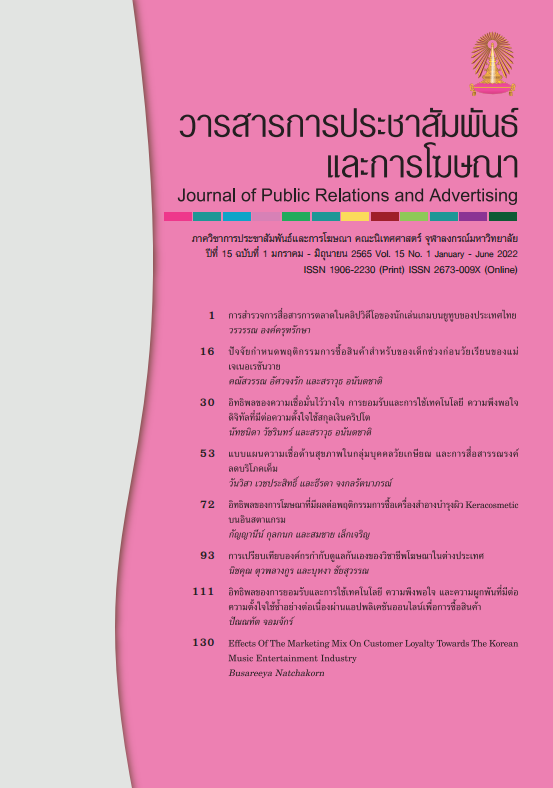Purchasing Determinants of Products for Pre-School Children of Generation Y Mothers
Main Article Content
Abstract
The objectives of this research are to study: 1) purchasing determinants for pre-school products of generation y mothers, and 2) influences of such determinants on purchase intentions. Using online survey, questionnaires were employed to collect data from 613 generation y mothers, aged 26-43 years old living in Bangkok, who had pre-school children, aged 2-5 years old. The findings showed that all four purchasing determinants, composed of personal factors (personality and information search), psychological factors (motivation and attitude toward buying), social factors (reference group and electronic word-of-mouth), and cultural factor (collectivism), were important for child’s stroller (utilitarian product) and cloth (hedonic product) purchases. In addition, for influences of these purchasing determinants on purchase intention, the results indicated that neurotic personality negatively influenced on purchases of both products. However, information search, attitude toward buying, and value-expressive influences from reference group positively influenced on such purchases.
Article Details
References
จันทิมา สุขเกิด. (2558). ปัจจัยที่ส่งผลต่อการตัดสินใจซื้อนมผงสำเร็จรูปสำหรับทารกแรกเกิดถึงหนึ่งปีของสตรีเจนเนอเรชั่นวาย. วิทยานิพนธ์ปริญญามหาบัณฑิต สาขาวิชาบริหารธุรกิจ มหาวิทยาลัยศิลปากร.
ณัฏฐพร ศุภสรรพตระกูล และชุติมาวดี ทองจีน. (2561). ปัจจัยที่มีอิทธิพลต่อการตัดสินใจซื้อเสื้อผ้าเด็กในกรุงเทพมหานคร. วันที่เข้าถึงข้อมูล 6 กุมภาพันธ์ 2563, แหล่งที่มา http://eprints.utcc.ac.th/6024/1/proceeding_0101%20%E0
%B8%93%E0%B8%B1%E0%B8%8E%E0%B8%90%E0%B8%9E%E0%B8%A3.pdf
The Asianparent. (2561). เผยผลสำรวจพฤติกรรมแม่ ชอบช้อปออนไลน์และเป็นผู้ทรงอิทธิพลในบ้าน. วันที่เข้าถึงข้อมูล 3 มีนาคม 2563, แหล่งที่มา https://th.theasianparent.com/
The Standard Team. (2561). Gen Y กับการเลือกซื้อคอนโดฯ เมื่อที่อยู่ไม่ใช่ที่ไหนก็ได้ แต่ work-life balance ก็ต้องดีด้วย. วันที่เข้าถึงข้อมูล 29 มกราคม 2563, แหล่งที่มา https://thestandard.co/maru-gen-y-work-life-balance/
ธนัทอร นาราสุนทรกุล. (2558). กลยุทธ์ทางการตลาดในมุมมองของผู้บริโภค: กรณีศึกษาวิสาหกิจขนาดกลางและขนาดย่อมผลิตภัณฑ์สาหรับเด็ก. วิทยานิพนธ์ปริญญามหาบัณฑิต สาขาวิชาการบริหารเทคโนโลยี มหาวิทยาลัยธรรมศาสตร์.
นภวรรณ คณานุรักษ์. (2555). การตลาดสำหรับแม่และเด็ก: กระบวนการตัดสินใจจองผู้บริโภคสี่ตาสี่ขาและอิทธิพลของเด็กที่มีต่อแม่. วันที่เข้าถึงข้อมูล 3 มีนาคม 2563, แหล่งที่มา http://www.tpa.or.th/publisher/pdfFileDownloadS/qm173_p71-73.pdf
มาร์เก็ตบัซซสำรวจเสียงจากคุณแม่แท้ๆ. (2560, 9 สิงหาคม). วันที่เข้าถึงข้อมูล 3 มีนาคม 2563, แหล่งที่มา https://www.
matichon.co.th/lifestyle/tech/news_623700
Marketeer. (2561). ตลาดของใช้สำหรับเด็กเป็นอย่างไร ในวันที่เด็กเกิดน้อยลง. วันที่เข้าถึงข้อมูล 3 มีนาคม 2563, แหล่งที่มา https://marketeeronline.co/archives/69581
ศูนย์วิจัยกสิกรไทย. (2562). SME แบ่งเค้กก้อนโต ตลาดสินค้าแม่และเด็ก. วันที่เข้าถึงข้อมูล 3 มีนาคม 2563, แหล่งที่มา https://
www.kasikornbank.com/th/business/sme/KSMEKnowledge/article/KSMEAnalysis/Documents/Child_ProductMarket.pdf
Assael, H. (2004). Consumer behavior: A strategic approach. Boston, MA: Houghton Mifflin.
Bearden, W. O., Netemeyer, R. G., & Teel, J. E. (1989). Measurement of consumer susceptibility to interpersonal influence. Journal of Consumer Research, 15(4), 473-481.
Belleau, B. D., Summers, T. A., Xu, Y., & Pinel, R. (2007). Theory of reasoned action: Purchase intention of young consumers. Clothing & Textiles Research Journal, 25(3), 244-257.
Bhatai, V. (2018). Examining consumers’ attitude towards purchase of counterfeit fashion products. Journal of Indian Business Research, 10(2), 193-207.
Chang, Y., Ko, Y. J., & Jang, W. (2019). Personality determinants of consumption of premium seats in sports stadiums. International Journal of Contemporary Hospitality Management, 31(8), 3395-3414.
Feigelman, S. (2016). The preschool years. In R. M. Kliegman, B. F. Stanton, J. W. St. Geme & N. F. Schor (Eds.), Nelson textbook of pediatrics (20th ed., pp. 76-79). Philadelphia, PA: Elsevier.
Forstner, A. M. (2014). First-time mothers and their pre-purchase behavior in regards to baby products: An exploratory research on the relationship between perceived risk, information search behavior and the purchase decision of first-time mothers (Master’s thesis). University of Amsterdam, Amsterdam, The Netherlands.
Hong, P. T. T. (2015). Factors influencing on purchasing formula milk for babies: An empirical research in Hanoi. International Journal of Business Administration, 6(5), 37-43.
Jain, S., Khan, M. N., & Mishra, S. (2017). Understanding consumer behavior regarding luxury fashion goods in India. Journal of Asia Business Studies, 11(1), 4-21.
Jin, B., & Koh, A. (1999). Differences between South Korean male and female consumers in the clothing brand loyalty formation process: Model testing. Clothing and Textiles Research Journal, 17(3), 117-127.
Killoran, E. (2019). Transition to motherhood: A reality check. Retrieved March 3, 2020, from https://www.familylifecanada.com/parenting/reality-check/
Lee, T. D. (2018). Influence of WOM and content type on online engagement in consumption communities: The information flow from discussion forums to Facebook. Online Information Review, 42(2), 161-175.
Lin, L. Y. (2010). The relationship of consumer personality trait, brand personality and brand loyalty: An empirical study of toys and video games buyers. Journal of Product & Brand Management, 19(1), 4-17.
Lin, L. Y., & Chen Y. W. (2009). A study on the influence of purchase intentions on repurchase decisions: The moderating effects of reference groups and perceived risks. Tourism Review, 64(3), 28-48.
Lutz, R. J. (1991). The role of attitude theory in marketing. In H. H. Kassarjian & T. S. Robertson (Eds.), Perspectives in consumer behavior (4th ed., pp. 317-339). Englewood Cliffs, NJ: Prentice Hall.
Nguyen, T., Nguyen, N., Nguyen, T., Phan, T., Bui, L. P., & Moon, H. C. (2019). Investigating consumer attitude and intention towards online food purchasing in an emerging economy: An extended TAM approach. Foods, 8(11), 1-15.
Noble, S. M., Haytko, D. L., & Phillips, J. (2009). What drives college-age generation Y consumers. Journal of Business Research, 62, 617–628.
Oe, H., Sunpakit, P., Yamaoka, Y., & Liang, Y. (2018). An exploratory study of Thai consumers’ perceptions of conspicuousness: A case of luxury handbags. Journal of Consumer Marketing, 35(6), 601-612.
Park, C. W., & Lessig, V. P. (1977). Students and housewives: Differences in susceptibility to reference group influence. Journal of Consumer Research, 4(2), 102-110.
Patterson, P. G., Mandhachitara, R., & Smith, T. (2001). Switching costs as a moderator of service satisfaction processes in Thailand. Journal of International Consumer Marketing, 14(1), 1-21.
Roberts, B. W., & Mroczek., D. (2008). Personality trait change in adulthood. Association for Psychological Science, 17(1), 31-35.
Ryan, R. M., & Deci, E. L. (2000). Self-determination theory and the facilitation of intrinsic motivation, social development, and well-being. American Psychologist, 55(1), 68-78.
Schiffman, L. G., Kanuk L. L., & Wisenblit, J. (2010). Consumer behavior (10th ed.). Upper Saddle River, NJ: Prentice Hall.
Septianto, F., & Chiew, T. M. (2018). The effects of different, discrete positive emotions on electronic word-of-mouth. Journal of Retailing and Consumer Services, 44, 1-10.
Solomon, M. R. (2017). Consumer behavior: Buying, having, and being (12th ed.). Harlow, UK: Pearson.
Sreen, N., Purbey, S., & Sadarangani, P. (2017). Impact of culture,behavior and gender on green purchase intention. Journal of Retailing and Consumer Services, 41, 177-189.
Teimourpour, B., & Hanzaee, K. H. (2011). The impact of culture on luxury consumption behavior among Iranian consumers. Journal of Islamic Marketing, 2(3), 309-328.
Watjatrakul, B. (2020). Intention to adopt online learning: The effects of perceived value moderating roles of personality traits. The International Journal of Information and Learning Technology, 37(1/2), 44-46.


